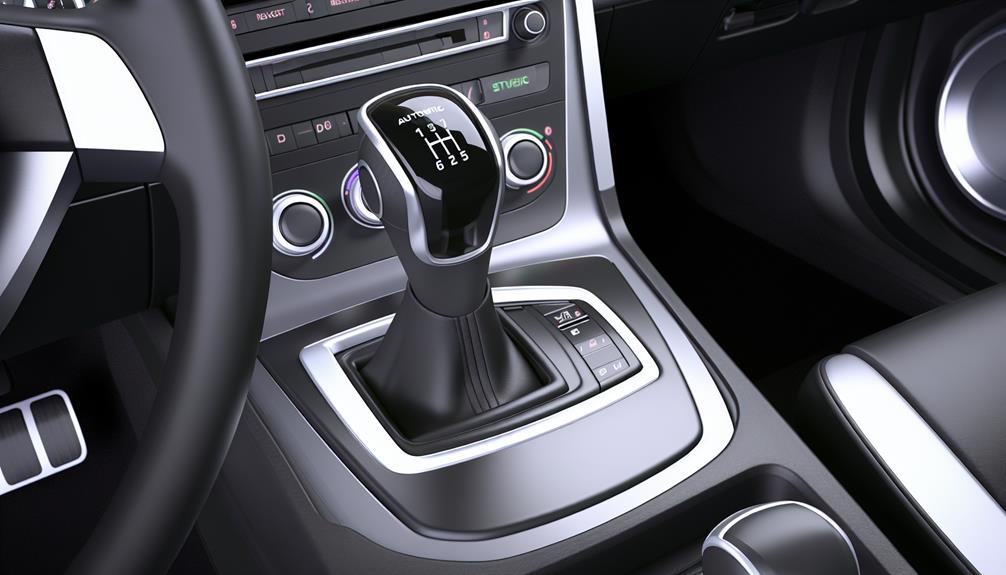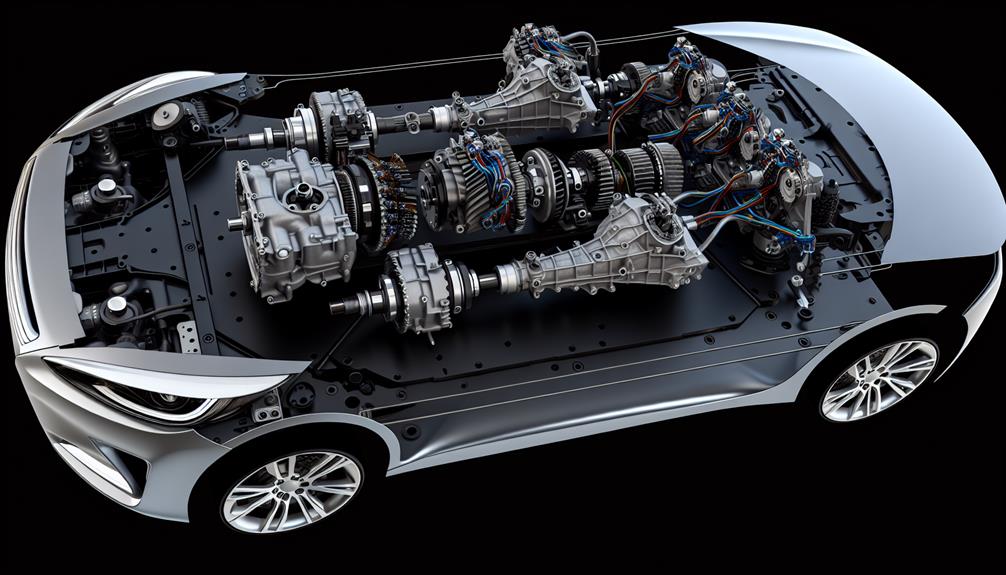Automatic cars have gears, controlled by advanced systems. They utilize planetary gear sets, hydraulic pressure, and computer algorithms for smooth shifting. Key modes include ‘P’ for park, ‘R’ for reverse, ‘N’ for neutral, and ‘D’ for drive. Each mode optimizes the vehicle’s performance based on speed and load.
Various types of automatic transmissions, like torque converters, dual-clutch, and Continuously Variable Transmissions (CVTs), improve driving dynamics. Strategic gear ratios, typically ranging from 4 to 10, further enhance fuel efficiency and acceleration. To grasp how these systems function and their benefits in-depth, there’s much more to uncover.
Contents
Understanding Automatic Car Gears

In automatic cars, understanding the specific functions of gears like P, R, N, and D is important for optimizing fuel efficiency and driving performance. Each gear in an automatic transmission serves a distinct role. The ‘P’ gear locks the transmission, securing the vehicle when parked.
‘R’ engages the reverse gear, enabling backward movement. N’ or neutral disengages the gears, allowing the vehicle to roll freely without engine power to the wheels. ‘D’ is for driving forward, where the automatic transmission selects the appropriate gear ratio based on speed and load.
Automatic transmissions simplify the gear-changing process, but knowing the function of different gears improves driving efficiency.
For instance, using ‘D’ allows the car’s computer to choose the best gear ratio, balancing power and fuel consumption. Gear ratios change seamlessly, improving engine performance and responsiveness in various driving conditions.
Understanding these gear functions isn’t just about convenience; it’s important for maximizing your car’s performance.
How Automatic Transmissions Work
To grasp how automatic transmissions work, it’s important to recognize that these systems utilize hydraulic pressure, planetary gear sets, and sophisticated computer algorithms to manage gear shifting seamlessly.
In an automatic transmission, the vehicle’s computer system continuously monitors driving conditions, including speed, load, and throttle position, to determine the best moment to shift gears.
Hydraulic pressure is central to the operation of an automatic transmission. The transmission fluid, under pressure, actuates clutches and bands that engage and disengage the planetary gear sets. The planetary gear sets, comprising sun gears, planet gears, and ring gears, allow for multiple gear ratios, enabling smooth transitions between gears without manual intervention.
The gear shifter allows you to select different modes such as Park (P), Reverse (R), Neutral (N), and Drive (D). Each of these positions instructs the automatic transmission on how to handle the vehicle’s movement.
For instance, selecting Drive (D) allows the transmission to shift through a range of gears automatically, optimizing performance and fuel efficiency based on driving conditions.
Understanding the intricacies of how an automatic transmission manages gear shifting can improve your driving experience, ensuring better control and a prolonged transmission lifespan.
Types of Automatic Transmission Systems

Several distinct types of automatic transmission systems exist, each employing unique mechanisms to manage gear shifting and optimize vehicle performance. In traditional automatic cars, the most common system uses a torque converter and planetary gear sets.
The torque converter replaces a manual clutch, allowing for smooth engagement and disengagement of gears. Planetary gear sets offer multiple gear ratios and are critical for automatic transmission systems because of their compact design and efficiency.
Dual-clutch transmissions (DCT) utilize two separate clutch packs to preselect gears, providing faster and more efficient shifts. Continuous Variable Transmissions (CVT) differ by using a pulley system instead of fixed gears, delivering an infinite range of gear ratios and smooth acceleration.
Automated Manual Transmissions (AMT) blend manual gearbox elements with automatic controls, using actuators to handle gear shifts.
Intelligent Manual Transmission (IMT) is a recent innovation that combines manual transmission control with automated clutch engagement.
Each of these automatic transmission systems employs specific components like torque converters, planetary gear sets, and clutch packs to improve driving performance. Understanding these systems helps you choose an automatic car that aligns with your driving preferences and needs.
When to Use Different Gears
Understanding the best use of different gears in automatic cars improves both performance and fuel efficiency. Each gear in an automatic transmission is designed for specific driving situations, and knowing when to use them can make a significant difference.
You should use gear 1 when you’re starting from a complete stop to get the highest torque and acceleration. Gear 2 is ideal for traversing city streets or when you’re stuck in slow-moving traffic. If you’re cruising on the highway or need to pass another vehicle, gear 3 offers a good balance of power and fuel efficiency.
Gear 4 is tailored for high-speed driving, ensuring efficient fuel consumption. Lastly, gear L, while not a traditional gear, is essential for very low speeds and specialized transmission functions, providing the necessary control and precision in unique driving situations.
Benefits of Automatic Transmissions

You’ll find automatic transmissions significantly improve driving comfort by eliminating the need for manual gear changes.
They also boost fuel efficiency through optimized gear ratios controlled by the vehicle’s computer system.
Enhanced Driving Comfort
Automatic transmissions greatly improve driving comfort by seamlessly managing gear shifts through the vehicle’s computer system. In automatic cars, the gears are labeled numerically and controlled automatically, eliminating the need for manual intervention.
This automation translates into a significant reduction in the cognitive load on the driver, as you no longer need to focus on shifting gears manually.
The automatic transmission system adjusts gears in response to vehicle speed and driving conditions, providing a seamless driving experience.
The system continuously monitors various parameters and guarantees that gear transitions are smooth and ideal for driving comfort. The precise management of gear changes contributes to a more relaxed and less stressful driving experience, especially in stop-and-go traffic or during long-distance travel.
Moreover, automatic cars offer enhanced driving comfort by allowing you to focus more on the road and less on the mechanics of driving.
This is particularly beneficial for novice drivers or those who find manual gear shifting cumbersome. The automatic transmission system’s ability to provide a consistent and smooth drive makes it an attractive option for those seeking convenience and comfort in their daily commute.
Improved Fuel Efficiency
Integrating multiple gears in automatic transmissions optimizes engine performance and greatly improves fuel efficiency. By employing a range of gear ratios, typically from 4 to 10 forward gears, automatic transmissions guarantee that the engine operates at its most efficient speed, regardless of driving conditions. This optimization significantly boosts fuel economy.
One of the key advancements in modern automatic transmissions is their ability to adjust gear ratios seamlessly. This seamless gear shifting maintains the engine’s peak efficiency, reducing fuel consumption more effectively than manual transmissions. The sophisticated technology embedded in these systems continuously analyzes driving conditions to select the most appropriate gear, ensuring fuel efficiency across various terrains and speeds.
Here is a comparative analysis of automatic transmissions’ impact on fuel efficiency:
| Feature | Automatic Transmissions | Manual Transmissions |
|---|---|---|
| Gear Ratios | 4 to 10 forward gears | Typically 5 or 6 gears |
| Gear Shifting | Seamless gear shifting | Driver-dependent shifting |
| Engine Efficiency | Optimized across speeds | Variable, less consistent |
| Fuel Consumption | Reduced as a result of optimization | Potentially higher |
| Modern Technology | Advanced, adaptive systems | Limited technological aids |
Maintenance Tips for Automatic Transmissions
To maintain the longevity and efficiency of your automatic transmission, check the fluid level every 30,000 miles and change it every 60,000 miles.
Scheduling regular transmission system flushes and services at 30,000-mile intervals is essential for peak performance.
Address any unusual noises or smells promptly to prevent potential issues.
Fluid Level Checks
Monitoring your transmission fluid level is important for ensuring the smooth operation and longevity of your automatic car’s gearbox. Automatic transmissions rely heavily on the proper amount and quality of transmission fluid to function correctly.
Performing fluid level checks at regular intervals—ideally, every 30,000 miles—is a preventive measure to prevent potential issues before they escalate into costly repairs.
Transmission fluid is both a lubricant and a coolant for the intricate components of your automatic transmission. By conducting these checks, you guarantee that the fluid remains at an ideal level, maintaining the efficiency and performance of the system. Low fluid levels can lead to overheating and excessive wear, compromising the transmission’s functionality.
To perform a fluid level check, locate the transmission dipstick, usually found near the engine bay. Remove the dipstick, wipe it clean, reinsert it, and then pull it out again to read the fluid level. If the fluid appears dark or has a burnt smell, it may be time for a fluid change.
Incorporating regular checks and promptly addressing any discrepancies can significantly prolong your automatic transmission’s lifespan and reliability.
Regular Service Intervals
Performing regular service intervals, including fluid changes every 60,000 miles and system flushes every 30,000 miles, is pivotal for maintaining the efficiency and longevity of your automatic transmission. These maintenance tasks guarantee that the transmission system operates smoothly, reducing the risk of wear and tear on internal components.
Regular service intervals serve as a proactive measure to identify potential issues before they escalate into costly repairs. Fluid level checks every 30,000 miles are vital for detecting leaks or contamination that could compromise the transmission’s performance. By adhering to recommended fluid changes, you prevent the buildup of debris and sludge that can obstruct the transmission system.
Incorporating these maintenance tasks into your vehicle care routine helps sustain ideal fluid viscosity, critical for efficient gear shifting. The system flushes to remove old fluid and contaminants, promoting a clean environment within the transmission.
Moreover, addressing unusual noises or smells promptly can prevent minor issues from developing into significant problems.
Ultimately, consistent attention to regular service intervals and fluid changes ensures that your automatic transmission remains in top condition, enhancing your vehicle’s performance and lifespan.
Don’t overlook these critical steps in maintaining your vehicle’s transmission system.
Conclusion
In conclusion, automatic cars do have gears, managed seamlessly by sophisticated transmission systems. You’ll appreciate the convenience of automatic gear shifting, which optimizes performance and fuel efficiency.
Understanding when to use different gears and keeping up with routine maintenance guarantees your transmission operates smoothly.
Embrace the benefits of automatic transmissions, including ease of use and reduced driver fatigue, while staying informed about the technical aspects to maximize your vehicle’s longevity and performance.
